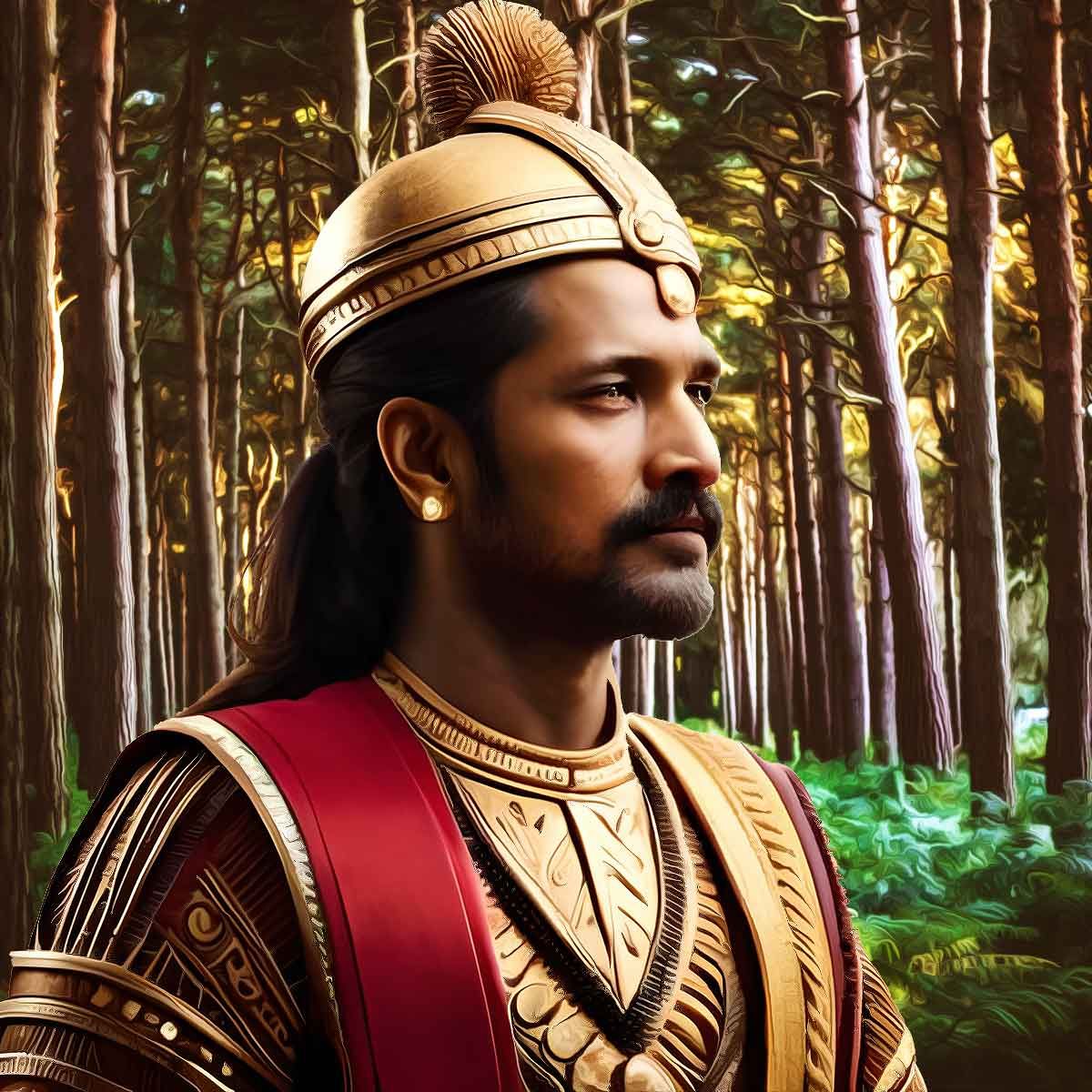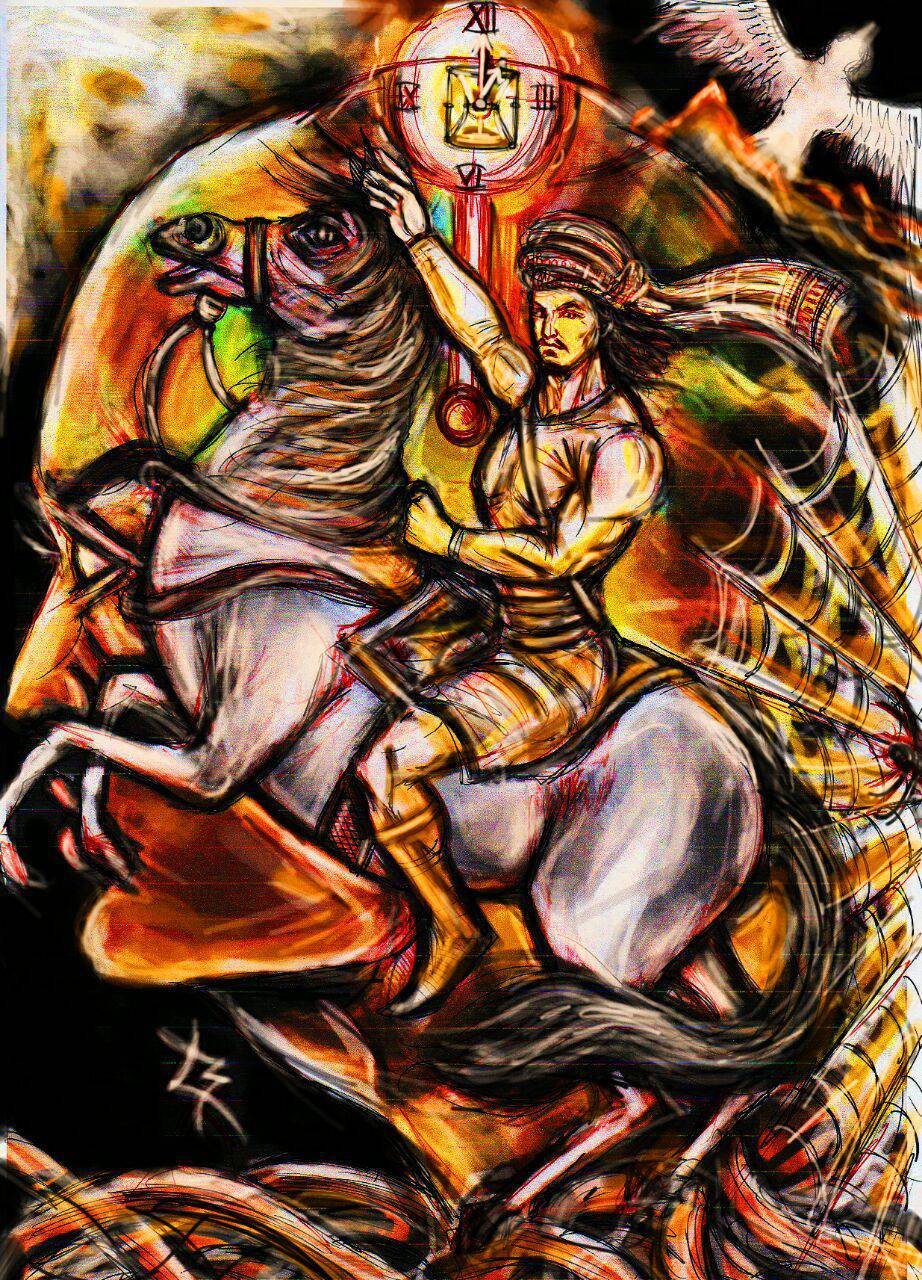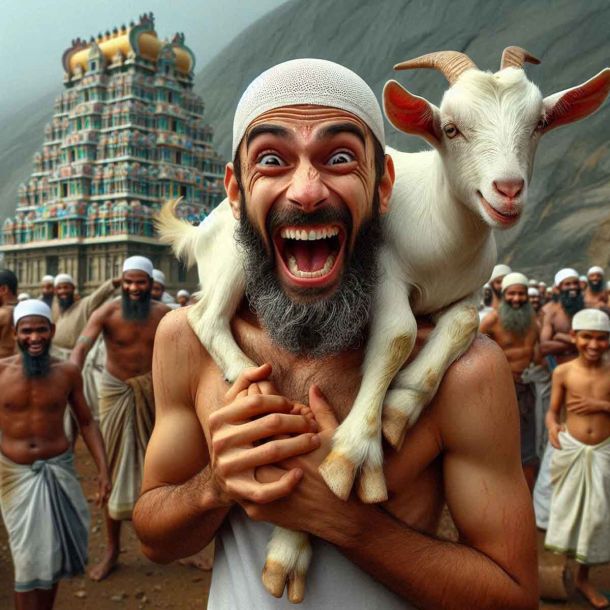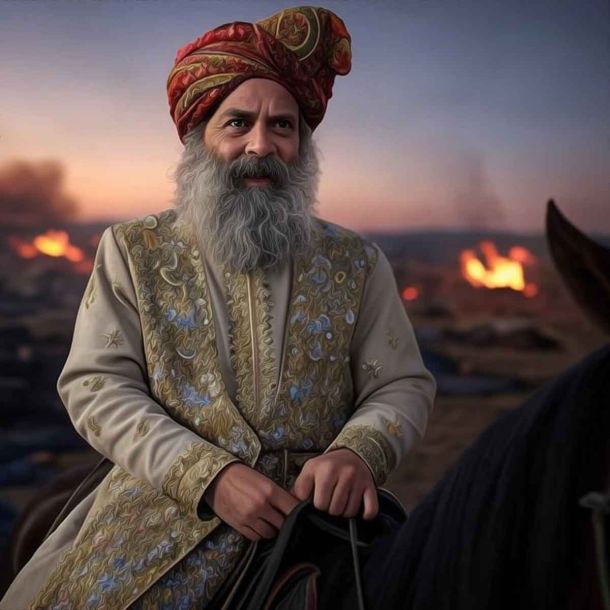More Coverage
Twitter Coverage
Satyaagrah
Written on
Satyaagrah
Written on
Satyaagrah
Written on
Satyaagrah
Written on
Satyaagrah
Written on
Join Satyaagrah Social Media
"Sing your death song and die like a hero going home": Courageous saga of Lachit Barphukan: Heroic defender of Assam who defied the Mughals, igniting a flame of Nationalism and Resilience for generations to embrace and preserve India's glorious heritage

In the annals of India's history, few warriors are as revered as Lachit Barphukan, a hero whose valor remains underappreciated due to the deliberate obscurity imposed by left historians. His legacy, a testament to India's fierce resistance against the Muslim rule, however, continues to inspire generations in his native Assam and beyond.
|
Lachit Barphukan, a brave warrior hailing from Assam, stands as a shining example of valor, nationalism, and the spirit of freedom. However, the true glory of this Bharatiya warrior has been intentionally concealed by left historians in Independent India. In the face of Muslim invasions, various Hindu kingdoms across India fiercely resisted, including the Rajputs, Marathas, Oriyas, and Assamese. Among the countless heroes who fought against Muslim imperialism, Maharaja Prithu and Mahabir Lachit Barphukan emerged as prominent figures.
Raktim Pator, an emerging historian from Assam and the author of the book "Maharaja Prithu," sheds light on the remarkable resistance displayed by Hindu kingdoms during the rule of Muslim dynasties. Despite the central power in Delhi attempting to subjugate the entire Indian subcontinent, they encountered fierce opposition from various Hindu forces, including the Rajputs, Marathas, Oriyas, and Assamese. Throughout history, from the initial Muslim invasion led by Bakhtiyar Khilji in 1206 to the late 18th century, Assam, in particular, emerged victorious in defending its territory on 22 separate occasions. This extraordinary achievement was made possible through the courageous acts of numerous heroes, among whom Maharaja Prithu and the indomitable Lachit Barphukan stand out prominently.
Assam's history is replete with the extraordinary feats of warriors who fiercely battled against fanatical forces in defense of their swadharma (religious duty) and Swadesh (homeland). However, these glorious chapters have been deliberately suppressed by left historians, primarily to conceal the valor of Hindu warriors. These historians have propagated a narrative that portrays Mughal and other Muslim rulers as secular, asserting that they never sought to Islamize India. Yet, historical evidence reveals their imposition of religious taxes on non-Muslims, invasions of Hindu kingdoms, destruction of Hindu temples, offering high ranks to those who converted to Islam, granting tax-free lands to converts, and forceful abduction of Hindu girls for religious conversion. These anti-Hindu policies clearly indicate the Muslim rulers' mission to convert India into a Muslim empire. Nevertheless, they were valiantly defeated by numerous Hindu warriors.
|
A Nation Builder and True Patriot | Lachit Barphukan stands as an undisputed national hero of India. His valor and leadership defended Assam, as well as regions in North East and South East Asia, from the clutches of Mughal imperialism. He united diverse communities from North East India under one banner to resist the Mughals, exemplifying the spirit of Indian nationalism.
Left historians have systematically downplayed the greatest victory of Bharatiya Veer Lachit against the Islamic invasion in Assam. While it was nearly impossible to erase the contributions of Veer Shivaji, who hailed from the mainland, the far-off location of Veer Lachit allowed these historians to obscure his glory from reaching the common Indians.
Dr. Subhajit Chaudhury, General Secretary of Itihas Sankalan Samiti Assam and Head of Section and Academic Affairs at IIT Guwahati, asserts that nation-building encompasses diverse facets. It involves fostering love and affection towards the nation, a sentiment embodied by Veer Lachit Barphukan. The love and commitment displayed by Lachit should resonate in the hearts and souls of every citizen, inspiring dedication in every assigned task.
Furthermore, learning from the strategies of adversaries and formulating appropriate plans remain vital in the present day. The involvement of waterways in warfare, reminiscent of ancient Indian warships known as Agramandira, offers insights into naval architecture and cost-effective transportation methods. Strengthening river borders, such as in Dhubri and Karimganj districts of Assam, can contribute to national security. The war tactics employed by Lachit Barphukan, contextualized to the present, can serve as valuable references for military and defense research.
|
The gallant act of Lachit Barphukan and the bravery exhibited by countless Indian warriors in the face of adversity should be celebrated, as it instills a sense of pride and inspiration among future generations of Bharat.
As India commemorated the 400th birth anniversary of Veer Lachit, left-liberals attempted to create a perplexing narrative around his identity. Was he solely an Ahom Assamese General, or does he deserve recognition as a Hindu warrior, akin to Veer Shivaji and Maharana Pratap? Historical evidence provides a resounding answer.
Professor Raktim Pator asserts that Lachit Barphukan drew inspiration from the Hindu goddess Kamakhya Devi for the war. Ahom soldiers adhered to customary rituals and consulted astrologers before commencing battles, a practice observed in all Hindu kingdoms across India. This suggests that Lachit, like other Ahom rulers and commanders, was a Hindu warrior who valiantly fought for swadharma and swadesh, protecting the people from the onslaught of Muslim fanaticism perpetuated by the Mughal rulers.
Dr. Subhajit Chaudhury's research has unveiled fascinating aspects of Lachit Barphukan's life, shedding light on his adherence to the Bharatiya Kalaganana (Hindu Calendar). Lachit, recognizing the significance of choosing an auspicious time for battle, sought the guidance of his astrologer to determine the perfect moment to launch an attack against the Mughal Army. Only after receiving the astrologer's declaration did he proceed with the assault. This strategic decision exemplifies Lachit's unwavering commitment to his Hindu beliefs.
Furthermore, Lachit Barphukan's in-depth study of naval warfare is evident in the historic Saraighat battle. Drawing inspiration from the naval practices of the ancient Indus Valley civilization, Lachit utilized his knowledge to devise tactics that would lead the Ahom army to triumph over the mighty Mughals. The findings suggest that Veer Lachit Barphukan was not only an Assamese commander-in-chief but also a devout Hindu, fighting courageously under the banner of the brave Ahom Kingdom.
Lachit Barphukan's deep reverence for Chatrapati Shivaji Maharaj, the founder of the Hindu empire, is a testament to his unwavering nationalism. The close relationship between these two great leaders inspired Lachit as he battled against the formidable Mughal forces. Lachit's fierce devotion to Maa Kamakhya, the Hindu goddess, was evident as he worshipped her before entering the battlefield, seeking her divine blessings and guidance in his fight against Aurangzeb's army.
The Ahom Dynasty, established in 1228 in Assam, embraced Hinduism and showcased their devotion through patronage of the Shakti Piths and the construction of temples. Assam's cultural tapestry is adorned with vibrant traditions, including the revered "Mahisa Mardini Durga Puja," alongside Vaishnavaite and Shaivite practices.
Under the reign of the mighty Ahom King Rudrasingha (1696-1714), a visionary who dreamed of a "Virat Hindu Rashtra," emissaries were dispatched to different Hindu kings to forge a united Hindu force. Unfortunately, Rudrasingha passed away before his vision could come to fruition, leaving a lasting impact on Assamese nationalism.
|
Born on November 24, 1622, during a tumultuous period in Assam's history, Lachit Barphukan witnessed the invasion of Assam by Mir Jumla, the Governor of Bengal, acting under the orders of the Mughal ruler Aurangzeb. The Assamese forces were overwhelmed, and Garhgaon, the capital of the ruling Ahom Dynasty, fell into the hands of the Mughals on March 17, 1662. The subsequent Treaty of Ghilajharighat, signed on January 23, 1663, imposed severe terms on the Ahom king Jaydhwaj Singha. The treaty compelled him to cede Ahom territories, pay war indemnities and an annual tribute, and send his only daughter to the imperial harem in Delhi. This humiliating agreement dealt a significant blow to the pride of Assamese nationalists.
Determined to restore their honor and reclaim lost territories, Chakradhwaj Singha, who succeeded Jaydhwaj Singha, embarked on a mission to oust the Mughal invaders and retrieve their homeland. Under the guidance of the renowned warrior-statesman Atan Burhagohain, the king initiated rigorous training for the soldiers, while simultaneously bolstering the armament industry and boat-making capabilities. By 1667, the preparations were complete, and Chakradhwaj Singha entrusted the relatively young Lachit Barphukan with the rank of Barphukan (commander), placing him in command of the Ahom army.
In August of that year, the Ahom army launched a rapid and relentless campaign, attacking and dismantling numerous Mughal outposts until they reached their primary target: Guwahati. Following a two-month siege, Lachit Barphukan launched a frontal assault on the fort on the night of November 4, 1667. The battle was fierce, resulting in the death of hundreds of Mughal soldiers. Those who managed to escape the fort and fled on boats were relentlessly pursued and driven beyond the Manas River.
Between 1667 and 1682, under a succession of rulers, beginning with Chakradhwaj Singha, the Ahom Dynasty launched a spirited counter-offensive, successfully reclaiming lost territories and liberating captives held by the Mughals. Lachit Barphukan, aware of the imminent Mughal retaliation, took proactive measures to strengthen the fortifications at Guwahati, ensuring the city's readiness to repel any attack.
Veer Lachit Barphukan's gallant efforts in defending Assam's freedom, his unwavering nationalism, and his profound devotion to Hindu traditions make him an immortal symbol of bravery and inspiration. His legacy reminds us of the indomitable spirit of our nation and stirs emotions of patriotism within our hearts. As we honor the memory of Veer Lachit Barphukan, let us cherish his extraordinary contributions and strive to embody the same spirit of courage and dedication to our motherland.
In 1669, Aurangzeb, the Mughal emperor, dispatched Raja Ram Singh I, a Rajput, to reclaim the territories that the Ahoms had regained. However, the Ahom defense preparations were ingenious and strategic. One notable example was in Guwahati, where the presence of hillocks on both banks of the Brahmaputra River provided the defenders with a vantage point. Lachit Barphukan, recognizing this advantage, closed the gaps between the hills by constructing earthen ramparts, creating a protective ring around Guwahati spanning approximately twenty-five miles in circumference.
News of the Mughal defeat reached Emperor Aurangzeb in Delhi in December 1667. In response, he assembled a massive army comprising 30,000 infantry, 18,000 Turkish cavalry, 15,000 Koch archers, and numerous war-boats. This formidable force was led by Raja Ram Singh, a member of the renowned Kuchchwa clan and the son of Raja Jai Singh of Amber.
During the initial stages of the Mughal campaign, no direct confrontation occurred. Raja Ram Singh hesitated to launch a direct assault on the well-fortified Ahom encampment at Guwahati. Lachit Barphukan, on the other hand, aimed to stall the Mughals' advance by land in order to lure them into a naval battle. As a result, numerous sporadic and limited engagements persisted throughout 1669 and 1670, with neither side gaining the upper hand.
 |
One significant battle during this period was the Battle of Alaboi, fought in 1669 near Dadara in North Guwahati. While the Mughals favored open warfare, Lachit Barphukan employed guerrilla tactics, launching relentless assaults on the Mughal forces. However, despite his valiant efforts, Raja Ram Singh eventually deployed his entire army of Rajput soldiers and experienced Mughal veterans, leading to Lachit's defeat.
The Battle of Alaboi, although resulting in a Mughal victory, prompted Raja Ram Singh to initiate negotiations for peace. Sadly, shortly after this battle, Chakradhwaj Singha, the ruler under whom Lachit Barphukan served, passed away in 1669.
Undeterred by the loss suffered at Alaboi, Lachit Barphukan, the epitome of a super strategist, devised foolproof war strategies to overcome the mighty Aurangzeb army of 60,000 soldiers. Dr. Subhajit Chaudhury elaborates on Lachit's ingenious tactics. Given the region's abundance of rivers and boats, Lachit capitalized on these resources, recognizing that the Mughals were unfamiliar with riverways and naval warfare. He swiftly mobilized the trained boatmen, transforming them into formidable soldiers in a remarkably short period.
Additionally, Lachit Barphukan rallied the indigenous people and harnessed their manpower, uniting them under a common goal of defending their motherland from the invading Mughals. Individuals from various communities, including Boro, Kochrajbongshi, Tiwa, Rabha, Garo, Karbi, and many others, contributed their boats to the cause. It is estimated that approximately 33,000 boats were deployed in a series of attacks, effectively halting and ultimately defeating the Mughals in the entire northeastern region of Bharat (India). The Battle of Saraighat marked the end of the Islamization of Southeast Asian countries, signifying a pivotal moment in history.
To further fortify their defenses, bamboo, which was abundant in the region, was utilized to construct stockades along the riverbanks, impeding the progress of the invaders. Dr. Gyanendra Barman highlights that the Mughal invasion was not only political but also cultural, resulting in the destruction of civilizations, trampling of cultures, confiscation of lands, desecration of religions, and the annihilation of magnificent artistic creations. However, the Mughals, despite their brutal attacks, failed to dominate the spirit of India. As the poet Matthew Arnold eloquently wrote, "She let the legion thunder past and plunged in thought again."
Throughout Bharat, resistance against the Mughal invasions prevailed, and the mighty Ahoms stood resolute in thwarting the Islamic onslaught in the northeastern part of the country. Yet, the glorious chapters of Hindu warriors, including the valorous deeds of Lachit Barphukan, have been deliberately concealed by left-leaning historians. They have crafted a false narrative of Mughal and Muslim rulers being secular, obscuring their attempts to Islamize India. However, the truth remains that the bravery, nationalism, and unwavering spirit of Hindu warriors played a significant role in defending the nation and preserving its cultural heritage.
The most notable battle in the heroic saga of Lachit Barphukan is the "Battle of Saraighat" in 1671. Lachit Barphukan, the General of the Ahom army, displayed unparalleled war strategy and unwavering dedication to his motherland, leaving an indelible mark in the history of Assam.
The campaign led by Raja Ram Singh, under orders from the impatient Aurangzeb, took a direct assault approach. The Mughal general was also encouraged by the news that Lachit Barphukan was seriously ill and bedridden, making him unable to lead the Ahom army.
To halt the Mughal army's progress, Lachit Barphukan devised a plan to construct a fort near Saraighat overnight. Recognizing that Saraighat, near Guwahati, presented the ideal location to impede the Mughals, as the river was narrowest at this point, merely 1 kilometer wide, Lachit strategically retreated to Guwahati. His objective was to force the Mughals into the water by constructing a series of mud walls or embankments around Guwahati. These earthen walls seamlessly connected with the existing hills, forming a formidable barricade. One of these strategically important walls on the north side was assigned to his maternal uncle.
 |
Legend has it that when Lachit inspected the progress of the work on the eve of the battle, he was astonished to find the workers sleeping under the stars. When questioned about this, his uncle explained that the workers were fatigued, so he allowed them to rest. Enraged by this response, Lachit drew his sword in wrath and swiftly beheaded his uncle, declaring, "Dekhot koi Momai Dangor Nohoi," which meant, "My uncle is not greater than my motherland." This act awakened the workers, who immediately resumed their duties, ensuring the completion of the wall by morning. Lachit's unwavering commitment to his motherland and his firm stance against any obstacle or compromise exemplify his bravery and nationalism.
Despite being seriously ill at the time of the Mughal invasion, Lachit's determination to defend his land did not waver. The famous Battle of Saraighat commenced in March 1671, marking a moment when the Ahoms struck a fatal blow to the Mughal expansionist ambitions. Initially, the absence of Lachit at the helm demoralized the Ahom soldiers, and the risk of defeat loomed large. News of this reached the gravely ill Barphukan, prompting him to give stern instructions. With the help of his attendants, Lachit was carried onto a war-boat, which swiftly rowed towards the enemy. Miraculously, upon seeing Lachit leading them, the soldiers regained their courage and hope, energized by their revered leader's presence. The Mughal forces were relentlessly pursued, eventually fleeing beyond the Manas river. It was a resounding and decisive victory for the Assamese.
Lachit Borphukan emerged as the victorious hero. The Mughals were forced to retreat from Guwahati, and the Ahoms pursued them to the Manas river, securing the western boundary of the Ahom kingdom. Following the victory at Saraighat, Lachit Barphukan's health declined due to natural causes, and he passed away approximately a year later. His mortal remains find eternal rest at the Lachit Maidam, constructed in 1672 by Swargadeo Udayaditya Singha at Hoolungapara, 16 kilometers away from Jorhat. Lachit Barphukan's legacy as a symbol of indomitable courage and his strong, selfless, and visionary leadership remain deeply ingrained in the hearts and minds of the Assamese people. Each year on November 24th, Assam celebrates Lachit Divas, a state-wide commemoration of Lachit Barphukan's heroism and the victory of the Assamese army at the Battle of Saraighat.
|
The Battle of Saraighat showcased Lachit Barphukan as a master strategist, comparable to great generals from across India. His brilliant combination of guerrilla tactics, subterfuge, diplomacy, audacity, and psychological warfare proved instrumental in overcoming the Mughal army, despite being significantly outnumbered. The construction of Lachit Maidam by Swargadeo Udayaditya Singha stands as a testament to the unwavering respect and reverence Lachit Barphukan commands from the people of Assam. By ensuring that the North Eastern region remained free from Mughal dominion until the arrival of the British, Lachit Borphukan's remarkable bravery safeguarded sacred sites like Kamakhya and Pua Mecca from falling into the ruthless hands of the Mughals.
The prestigious Lachit Barphukan Gold Medal, instituted in 1999, is awarded to the best cadet from the National Defence Academy, acknowledging the heroic legacy of Lachit Barphukan and his significant contribution to the North Eastern region of India. It is disheartening to note that left-leaning historians have deliberately obscured the bravery and vision of Lachit Barphukan, causing a great injustice to this valiant warrior who fought for Bharat (India) with unyielding Hindu pride. The Ahoms and Lachit Barphukan have played a vital role in shaping the North Eastern region of India, and their invaluable contributions deserve recognition and celebration.
 Support Us
Support Us
Satyagraha was born from the heart of our land, with an undying aim to unveil the true essence of Bharat. It seeks to illuminate the hidden tales of our valiant freedom fighters and the rich chronicles that haven't yet sung their complete melody in the mainstream.
While platforms like NDTV and 'The Wire' effortlessly garner funds under the banner of safeguarding democracy, we at Satyagraha walk a different path. Our strength and resonance come from you. In this journey to weave a stronger Bharat, every little contribution amplifies our voice. Let's come together, contribute as you can, and champion the true spirit of our nation.
 |  |  |
| ICICI Bank of Satyaagrah | Razorpay Bank of Satyaagrah | PayPal Bank of Satyaagrah - For International Payments |
If all above doesn't work, then try the LINK below:
Please share the article on other platforms
DISCLAIMER: The author is solely responsible for the views expressed in this article. The author carries the responsibility for citing and/or licensing of images utilized within the text. The website also frequently uses non-commercial images for representational purposes only in line with the article. We are not responsible for the authenticity of such images. If some images have a copyright issue, we request the person/entity to contact us at This email address is being protected from spambots. You need JavaScript enabled to view it. and we will take the necessary actions to resolve the issue.
Related Articles
- Birth of our National Anthem: Original recording of 'Jana Gana Mana' performed by the Radio Symphony Orchestra of Hamburg, Germany, 1942 in the presence of Netaji Subhash Chandra Bose
- “Sometimes you have to pick the gun up to put the Gun down”: Bhagwati Charan Vohra and Bhagat Singh threw ‘Philosophy of Bomb’ in response to "Cult of Bomb" by Gandhi who launched a crusade against revolutionaries that cost him his career
- Christian evangelists offend the local cultural ethos of Assam by appropriating Bihu dance music to convert members of backward communities of Nepalese and Adivasi / Banvasi who work in the tea gardens of Assam
- "True icons are larger than life, unforgettable with an elegance that's mesmerizingly timeless": Do you know on occasion of birth anniversary celebrations of Netaji Bose on 23 Jan 1949, Ukkirapandi Muthuramalinga Thevar announced that Bose was alive
- Pratapgad Fort in Mahabaleshwar was completed in 1656 under the orders of the Maratha king Chhatrapati Shivaji: This fortress played a key role in the battle that would ultimately give rise to the Maratha Empire
- British author Tunku Varadarajan tried to tarnish the image of iconic freedom fighter Netaji with reference to Hitler: Sinister agenda to malign the legacy of Netaji from calling him a ‘flawed hero’ to a ‘Nazi sympathiser’
- Saraswathi Rajamani, at 16, became the youngest and first female spy for INA, boldly recruited by Netaji in 1942, courageously spent two years spying on the British in Myanmar during WWII, a pivotal yet overlooked heroine in India's struggle for freedom
- "Heroes are ordinary people that have achieved extraordinary things in life”: Samadhi of Hemachandra Vikramaditya, the last Hindu king to sit throne of Delhi, one of India's best military generals, achieving victory spree in 22 battles converted to Dargah
- Remarkable return to Uttar Pradesh of Dr. Gita Patel, a Sardar Vallabhbhai Patel's descendant, embraces the state's good governance under Aditya Yoginath, she ushers in a groundbreaking revolution in cancer treatment, shaping a brighter future for UP
- "बालनिकाह": Assam Police arrested 5348 people including Qazis since Feb 2023 in a crackdown on child marriages under CM Himanta Biswa Sarma’s vision to end this evil by 2026 with 5842 cases filed reducing maternal deaths to 372 and infant deaths to 4790
- How Political ambitions of the Congress has silenced contributions of uncountable freedom fighters
- The Eki Movement of hero Motilal Tejawat whose last wish is still waiting to be fulfilled - 100 years of Palchitaria massacre in Gujarat and its cover-up by the British govt
- A troubled childhood - Rajguru: The Invincible Revolutionary
- “Everything you’ve ever wanted is on the other side of fear”: Mula Gabharu, one among phenomenal patriotic women who fought with Mughals for her husband, for motherland, called the people of Assam to fight Mughals by taking Ahom sword in their hands
- "Remember that the greatest crime is to compromise with injustice and wrong": NSA Ajit Doval during the inaugural at Netaji Subhas Chandra Bose Memorial event in New Delhi claimed that "India would not have been partitioned if Subhas Bose was alive"
























